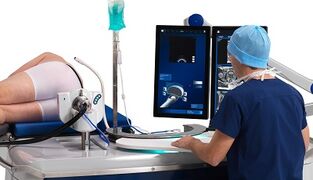Congestive prostatitis is a disease that occurs under the background of abnormal prostate function. The main cause of disease development is prostate stagnation. Men of all ages will have similar pathologies. Recently, cases of this disease have become more frequent in young people.
Reason

The occurrence of prostate arrest always indicates the development of the inflammatory process, which prevents the full function of the male prostate. The process of blood flow becomes difficult and the gland is no longer completely empty, as a result of which its secretion is stagnated.
This disease often develops in the context of chronic prostatitis. Therefore, the patient may be unaware of the stagnation process in the body for a long time.
Prostate hyperemia may occur due to various reasons. Generally, this disease is non-bacterial and manifests itself due to the influence of the following factors:
- Lack of continuous private life. Frequent excitement without subsequent ejaculation, inconsistent sexual contact, incomplete ejaculation, and frequent sexual behavior after prolonged abstinence can lead to a stagnant process.
- Anatomical features. If a person has insufficient venous valves or weakness in the vein walls of the urogenital plexus.
- Spinal injuries, and diseases such as herniated discs or osteochondrosis. With physical damage to the spine, prolonged spasm of the prostate glands may occur.
- Frequent hypothermia of the body, working in a room with active air conditioning, a room with ventilation, etc.
- Bad habits-smoking, alcoholism. As a result, patients may experience paralysis of small blood vessels in the genitourinary system.
- Chronic increase in temperature of the pelvic organs. This phenomenon can also be attributed to anatomical features.
- Colitis and diarrhea are frequent.
- Eating problems, dehydration.
Most experts believe that the main cause of stagnation is varicose veins in the lower extremities. In this case, the circulation of the pelvic organs is violated, so the prostate begins to fill with blood.
Usually, the cause of the disease may be an inflammatory process located in the pelvic organs or rectum. Moreover, the disease may be caused by hormonal destruction.
Various acute or chronic infections can also cause prostate arrest. The infection penetrates through the urethra to the prostate. Similarly, infections may occur through the rectum, blood or lymph vessels.
Who is at risk

Sedentary work is a direct way to stop prostatitis.
Although the disease develops suddenly, it can be prevented if the predisposing factors are eliminated in daily life. The risk of being in the process of prostate arrest is:
- Sedentary people. First, we are talking about people who are sitting at work.
- Patients with frequent constipation.
- People who have irregular diet and neglect healthy and nutritious food.
- Smokers and severe alcohol dependence.
Symptoms
In most cases, this disease is asymptomatic, so it is almost impossible to determine whether it is present at home. The first sign of disease is pain in the perineum. Walking usually gets worse. However, the disease has certain symptoms and should be discussed in more detail.
The main symptoms of congestive prostatitis are:
- Decreased performance and libido. The erection worsens.
- The number of sperm decreases and consistency decreases.
- Often premature ejaculation.
- The quality of the orgasm decreases.
- There is a constant burning sensation in the urethra and bladder.
- Urination problems are intermittent and painful.
- Groin pain extends to the ac bone or inner thigh.
- Continuous burning and discomfort in the bladder and urethra.
Non-specific symptoms of congestive prostatitis include general weakness, decline in function, sleep disturbance and general irritability.
Classification
At present, the hyperemia of the prostate can be observed through the following types of prostatitis:
- Chronic.Usually, it develops without regular sex or being replaced by masturbation. Obesity, interrupted sexual intercourse, stress, insufficient blood supply, sedentary lifestyle-all these factors ultimately lead to the development of chronic prostatitis. In chronic prostatitis, ejaculation is usually secreted as a clot. Prostate massage or sexual intercourse can improve the patient's condition, but this effect is short-lived.
- Veins.Appears in the case of venous system disease. If the patient’s varicose veins result in accumulation of venous blood in the venous system of the small pelvis, the stagnant process may also be located in the prostate. The result is prostatitis.
- Congestion.It occurs due to the partial emptying of the prostate gland. Therefore, it is always in a state of blood overflow, which helps the development of inflammation. This form of prostatitis is most common in middle-aged men.
- is contagious.In this case, the cause of the disease is an infection that enters the prostate through the urinary system. If this occurs in the process of cognitive prostatitis, the inflammatory process will intensify and the patient's general condition will deteriorate.
Diagnosis

An ultrasound examination of the prostate will help accurately determine the image of the disease.
Diagnostic measures must include palpation of the prostate and examination of the urethra. This is the basis for diagnosing prostatitis, allowing experts to determine whether sensitivity is low or high. Similarly, the presence of disease can be demonstrated by the release of meagre sterile secretions.
In addition, if the doctor suspects the development of the disease, the patient is sent to the prostate for rheological examination. The patient can tolerate this process well and it takes about 15 minutes on average. According to the results of rheology, the violation of venous outflow can be identified to obtain basic information about the state of the blood vessel-the elasticity and integrity of the blood vessel.
If it is difficult for blood to flow into glandular tissue, it indicates degenerative changes.
In order to confirm the diagnosis and obtain additional information, please follow the process below:
- Ultrasound examination of pelvic organs.
- Ultrasound examination of the prostate.
You cannot live without a laboratory diagnostic method, which involves passing the following tests:
- Urine examination.Including routine urinalysis, triple research and microflora culture. During these analyses, pathogenic bacteria including chlamydia are usually not detected.
- Blood test.We are talking about thromboelastography and coagulography.
- Analyze ejaculation and prostate secretions.In most cases, leukocytosis is not detected in congestive prostatitis. However, the sample contains images of columnar and squamous epithelium.
The difference between congestive prostatitis and infectious diseases

This disease is accompanied by frequent depression in men.
In the diagnosis phase, it is very important to distinguish the stagnant process from the infectious process. Otherwise, the incorrect choice of treatment may cause some complications. Therefore, experts should pay attention to the following symptoms:
- Urination problems-usually, patients urinate frequently in the morning. In addition, his condition has improved.
- Perineum, testicular pain and burning.
- The fever is accompanied by severe general fatigue.
- Depression and general anxiety.
- Erection problems and weak orgasms. Usually, the quality of a patient's ejaculation will decrease, which can be found in other studies.
Initially, doctors conducted palpation studies, during which time they revealed certain changes in the prostate. We can talk about the following features:
- Organ enlargement;
- The outline of the prostate is blurred;
- Consistency has been changed;
- Increased sensitivity;
- Note the smoothness of the median groove contour.
Important!In the case of the above symptoms, the patient showed no signs of infection during laboratory testing.
The secret feature of the prostate is thick, prominent in the form of lumps and blood clots. Similar changes can be observed with prostate massage. In some cases, the patient himself may notice a lump in the semen during ejaculation. This shows the development of a stagnant process.
Treatment
Treatment of the disease includes quitting smoking completely.
The treatment of congestive prostatitis depends on the degree of its manifestation. Based on the results of a thorough diagnosis, experts can determine the course of further treatment. Generally, it uses an integrated approach and includes the following process:

- medication.When treating prostate arrest, the patient needs to take anti-inflammatory drugs. The doctor can also prescribe other drugs to the patient.
- Analgesicscan be used for pain relief. They are usually taken with blood thinners.
- Power mode.When stagnant prostatitis is detected, the patient should strictly control his diet, with limited intake of spicy and fatty foods. The key to rapid recovery is a balanced diet, when the patient’s daily diet contains a lot of fruits, vegetables, fermented dairy products and fats.
- Sexual mode.It is very important for patients not only to observe sexual hygiene habits, but also to improve their private lives. Regular sexual intercourse will normalize the work of the prostate and rule out the development of stagnant processes in the future.
- Quit bad habits.Many experts do not know how to treat congestive prostatitis through smoking or alcohol abuse. It is important for patients to completely quit smoking and drinking, as this may cause traffic congestion. It is also important to minimize negative factors such as hypothermia, body overload, and physical inactivity.
- Physical activity.Most experts prescribe special physical therapy exercises for patients. This type of exercise is usually aimed at strengthening the abdominal muscles, improving breathing and conditioning the pelvic floor muscles.
- Vitamin therapy.This is a very important step in the treatment of congestive prostatitis. The patient's body must receive various nutrients. For this reason, vitamin complexes are most often prescribed for patients with congestive prostatitis.
If a person develops congestive prostatitis due to venous valve insufficiency in the lower limbs, surgery is required.
Prevention
In this case, the basis of preventive measures is activity. Moreover, it should be manifested in both sports and sex. Experts say that in order to prevent stagnation, the prostate must function normally. Only ejaculation can provide this.
Moderate exercise, frequent walking and a normal diet will help prevent the development of this disease.

























